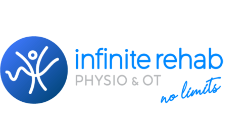Statistics suggest that one in three people over the age of 65 and once in two people over the age of 80 are at risk of a fall that will lead to serious injury. In Australia falls are the largest contributor to hospitalised injuries and a lead cause of injury deaths, leading to more than just broken bones.
At Rehab Health and Fitness Australia, community physiotherapists are highly skilled at assessing a patients balance and falls risk and are able to reduce the risk of a patient having a fall through exercise. Through well designed and patient tailed exercise programs created by the physiotherapist at rehab health and fitness Australia, patients are able to strengthen their body and improve their balance to assist in improving overall mobility confidence. This allows patients to stay intendent and more active on their feet for longer allowing them to do what they love most.
Physiotherapists also work with families and support workers to ensure each individual is aware of what to look out for and assist i
Sarcopenia describes an aged-related loss of skeletal muscle mass and strength (Watson, 2014). Beginning as early as the 4th decade of life, evidence suggests that skeletal muscle mass and strength decline in a linear manner, with up to 50% of mass being lost by the 8th decade of life (Metter et al., 1997).
Physiotherapy employs exercise as a crucial intervention in the management of sarcopenia because a wealth scientific evidence demonstrates the positive effects on muscle strength, quality and quantity and physical performance (Petersen et al., (2010); Tsuzuku et al., (2017); Jadczak et al. (2018)). Considering this, our physiotherapists are skilled in individualising an exercise program that considers your goals and priorities, whether it be to stand up from a low chair, to walk more or train movement patterns that are important in your daily activities. We offer multiple methods of physiotherapy delivery, such as home-visits, clinic-based or telehealth consultations, to provide you with greater choice and control to suit your circumstances.
In addition, our occupational therapists have an important partnership with our physiotherapists in recognising the impacts of sarcopenia on daily life. Occupational therapists can explore a range of strategies and interventions that can assist you in your daily activities, such as exploring assistive devices, assistive technologies, home assessments and modification recommendations, to ensure that your daily function at home and in the community promotes a continued quality of life.
Should you wish to access our physiotherapy and occupational therapy service or have questions, please drop us a line on reception@rhfaus.com.au or call us on (02) 8759 7222.
References
Metter EJ., Conwit R., Tobin J (1997). Age-associated loss of power and strength in the upper extremities in women and men; 52: B267-276
Watson, J (2012). Sarcopenia in older adults Current Opinion in Rheumatology. 24(6). p.623-627. DOI: 10.1097/BOR.0b013e328358d59b
Walking
Walking is entrenched in everything that we do, defines us for who we are and allows us to reach destinations that are important to us. The ability to walk has been associated with a higher quality of life because it allows us to complete activities of daily living, participate in social and economic pursuits, or is used to keep us healthy, facilitating a positive attitude and perception of our own health (Bechtold et al., 2021).
Physiotherapists are health professionals who are skilled in movement. They have insights into assessing the human walking pattern to then formulate strategies and interventions that suit your goals and priorities, whether it be to walk confidently after a joint surgery, be confident moving on your feet, learning how to use a walking aid or perhaps as part of a rehabilitation journey following a major life event.
Strengthening
Muscles are incredibly fascinating in what they do for us. There are different types of muscles. Some are involved in important body processes, such as digestion and circulating blood around our body, whereas the most common type is involved in creating and controlling movement, called skeletal muscles.
Skeletal muscles have an important bearing on our physical function because they produce movement at the joints, which then work collectively with our muscle groups to create the wide variety of movement that we depend on every day, such as standing up, walking and running. Making muscles strong and able to endure more work, as well as coordinating muscle groups to produce important movement patterns, are areas that physiotherapists are well-trained in to help improve aspects of one’s quality of life. Our physiotherapists provide a comprehensive assessment of the musculoskeletal system and your physical function to identify, formulate and create an individualised muscle strength and conditioning program using a variety of training methods and equipment, delivered at your home, at our clinics or via telehealth.
References:
Bechtold, U.; Stauder, N.; Fieder, M. Let’s Walk It: Mobility and the Perceived Quality of Life in Older Adults. Int. J. Environ. Res. Public Health 2021, 18, 11515. https:// doi.org/10.3390/ijerph182111515

